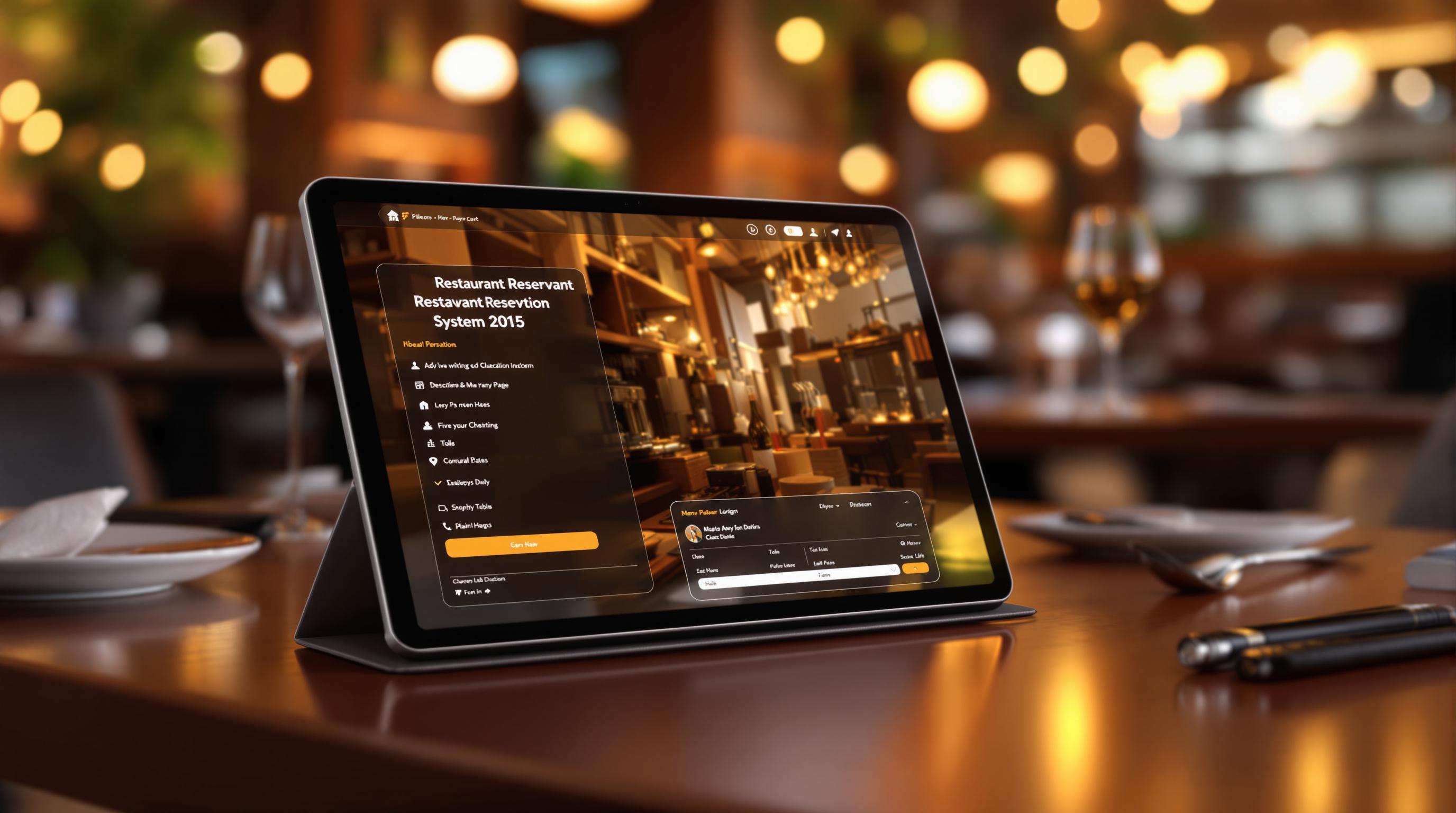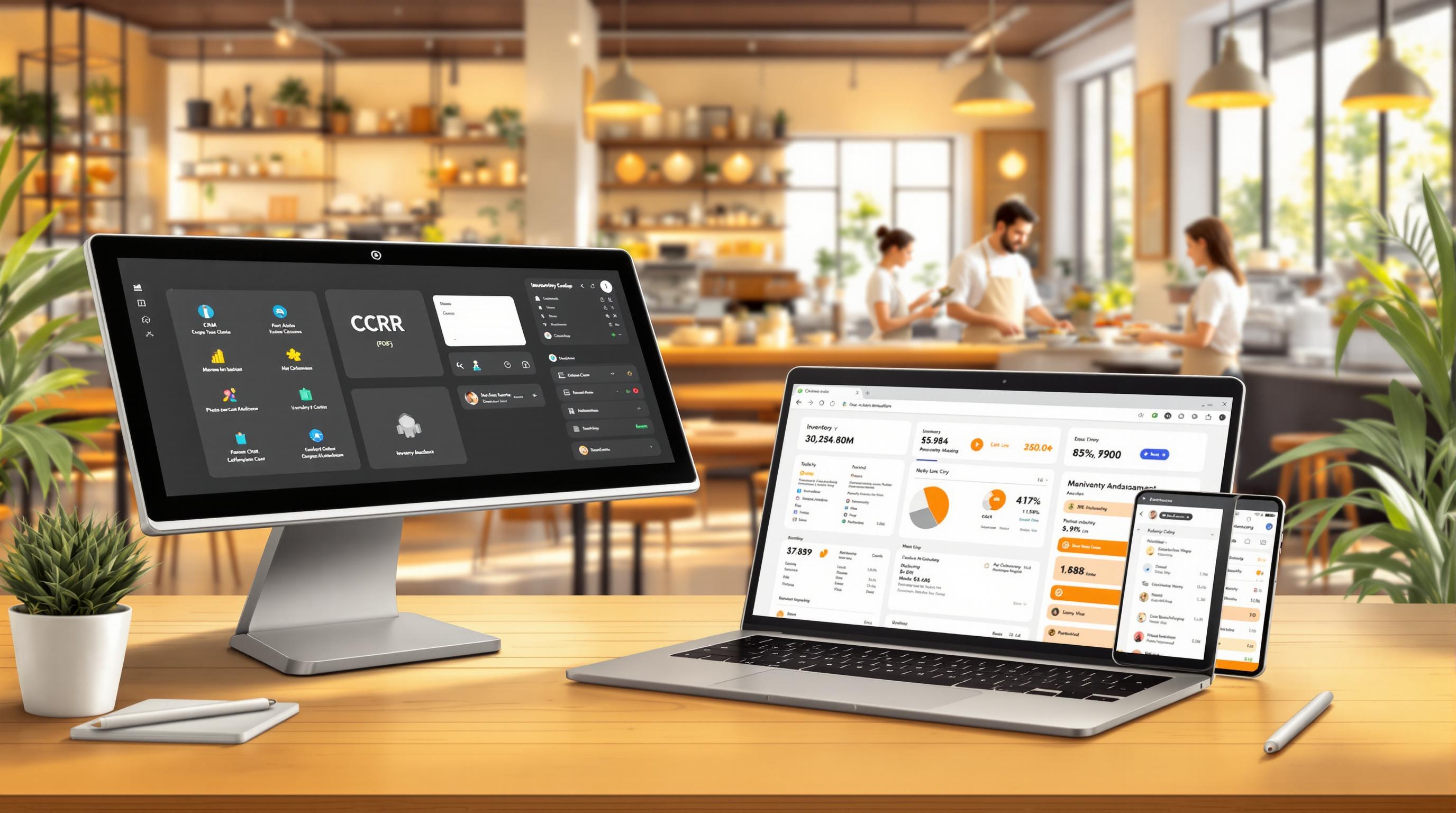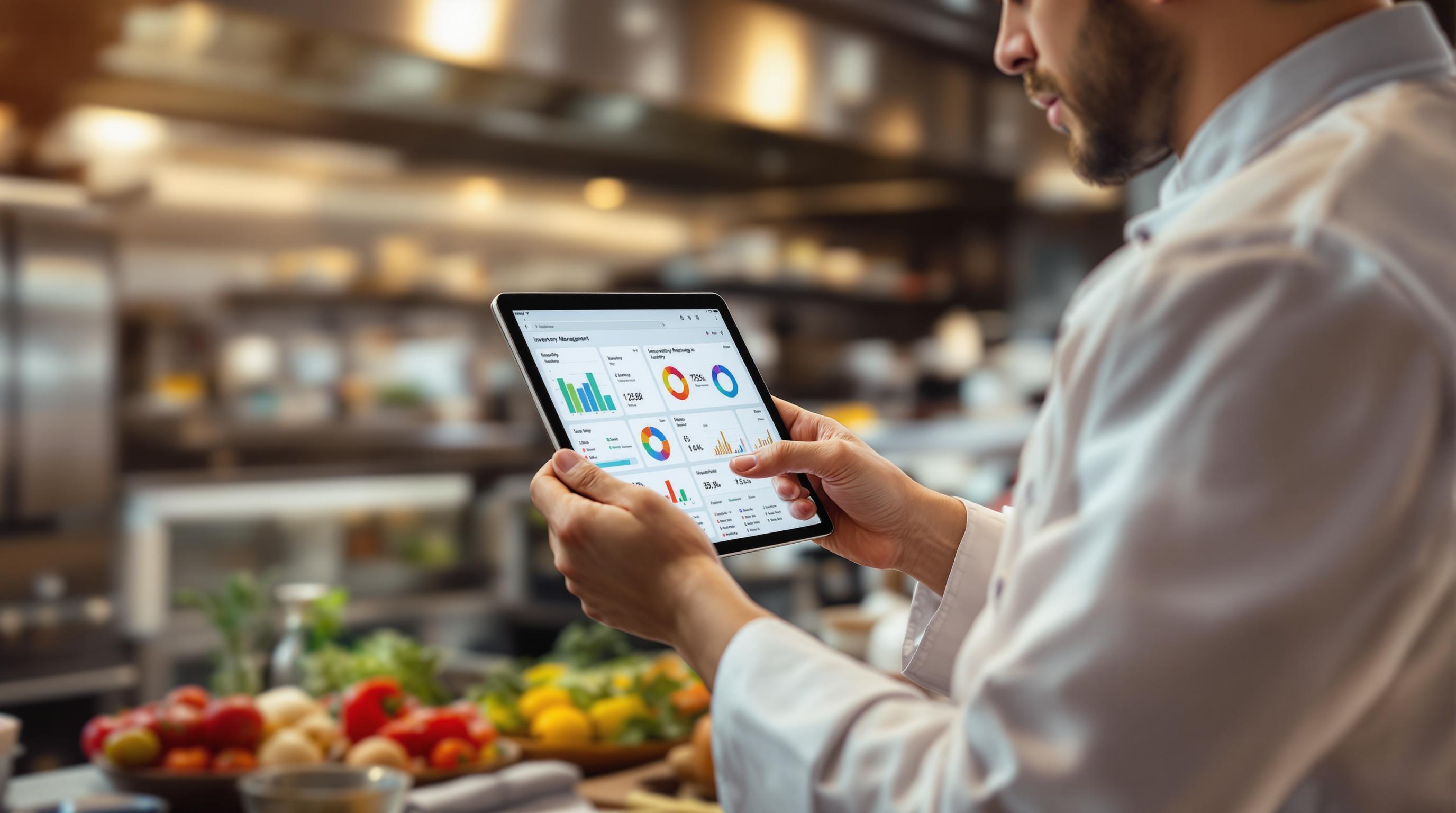- Identify Needs: Pinpoint challenges like inventory tracking, staff scheduling, or multi-location management.
- Key Features: Look for POS integration, inventory tools, reporting, and scalability.
- Compare Options: Test platforms like Toast POS, Upserve, or TouchBistro for usability and fit.
- Cost-Benefit Analysis: Balance initial and ongoing costs against potential efficiency gains.
- Plan Implementation: Ensure smooth deployment with proper training and support.
- Monitor Performance: Regularly review metrics like order accuracy and customer satisfaction.
Quick Comparison
| Feature | Toast POS | Upserve | TouchBistro |
|---|---|---|---|
| POS Integration | Yes | Yes | Yes |
| Inventory Management | Basic | Advanced | Moderate |
| Reporting Tools | In-depth | In-depth | Moderate |
| Scalability | High | High | Moderate |
| Ease of Use | Easy | Moderate | Easy |
This guide helps you select software that fits your business needs and supports growth. Let's dive into the details!
Toast POS vs TouchBistro vs Upserve vs Aloha vs Micros: Which POS Do You Need?

1: Identify Your Restaurant's Needs
Understanding your specific challenges and goals is the foundation for choosing the right software. This step ensures you pick tools that solve actual problems instead of adding unnecessary complications.
Pinpoint Current Challenges
Take a close look at your daily operations to identify where technology can make things smoother. Some common pain points include:
- Manual inventory tracking leading to stockouts, overstocking, or waste
- Inefficient scheduling and shift management for staff
- Unconnected systems for POS, inventory, and accounting
- Difficulties in managing multiple restaurant locations
Review your existing tools to uncover inefficiencies or areas where software could simplify your processes [1][3].
Define Business Goals
Set clear, measurable goals to guide your choices. Examples include:
- Cutting costs using data analytics
- Improving customer service with CRM tools
- Streamlining operations for better efficiency
- Preparing for growth and expansion
Think about both your current needs and future plans. For instance, software like Restaurant365 handles multi-location management, while Lightspeed offers flexible pricing for smaller setups [7].
When comparing software, prioritize how well it integrates with key systems like POS and accounting tools [6][8]. Also, set specific targets, such as reducing order processing time by 20% or increasing table turnover by 10% [8].
With your challenges and goals outlined, you're ready to match them with software features that meet your needs.
2: Review Necessary Software Features
After identifying your restaurant's needs, the next step is to focus on software features that match those requirements.
Key Features to Look For
Modern restaurant management software should include tools that help improve daily operations. Here are some must-have features:
- Point of Sale Integration: A reliable POS system is critical for smooth operations. It should seamlessly connect with inventory, accounting, and CRM tools while providing real-time updates on sales and stock levels. For example, Clover's POS system offers instant stock alerts and analytics, helping you maintain accurate inventory [4].
- Inventory Management: Keeping track of inventory reduces waste and ensures stock levels are optimized. Tools like Upserve’s inventory system categorize menu items by performance, making it easier to adjust your menu based on what sells best [2].
- Reporting and Analytics: Data-driven insights are essential for making smarter decisions. Look for software that provides details on revenue, peak hours, popular menu items, and customer preferences. Toast POS delivers in-depth analytics across locations, while Upserve offers performance metrics to refine your operations [2].
Planning for Growth
If your restaurant is growing, you’ll need software that can grow with you. Cloud-based systems are a great choice because they offer scalability and remote access [5]. Workpulse rOS, for instance, allows restaurants to customize features to fit their specific needs [1].
Features to Consider for Scalability:
- Support for managing multiple locations
- Flexible pricing options
- Integration with third-party tools like delivery services, accounting software, or marketing platforms
Some systems even let you adjust menus and pricing for different locations while keeping centralized control - perfect for businesses with multiple units.
3: Evaluate and Compare Software Options
Select Potential Software
Look into platforms that align with your restaurant's needs. Options like Toast POS, Upserve, and TouchBistro are designed to address various requirements in the industry [2].
When narrowing down your choices, pay attention to these critical factors:
- Integration Capabilities: Ensure the software works smoothly with systems you already use, such as accounting tools or delivery platforms [2][6].
- Customization Options: Opt for solutions that let you adjust features to suit your restaurant's specific needs [2].
- Mobile Accessibility: Prioritize software that offers mobile access, allowing you to manage operations remotely [2].
Test Software
Once you’ve identified potential options, hands-on testing is essential to confirm the software meets your needs. This step helps you see how it performs in real-world scenarios [1][2].
User Interface Assessment
- Check how quickly staff can complete tasks using the software.
- Evaluate whether the interface is intuitive and how much training it requires.
- Review the clarity of error messages and the usefulness of help documentation.
Functionality Testing
TouchBistro, for example, is known for its easy-to-use interface [2]. Focus on these areas during testing:
- POS Operations: Test how efficiently the system handles payments, table management, and general speed.
- Inventory Management: Make sure it tracks stock accurately, sends alerts, and monitors ingredients effectively.
- Reporting Tools: Look for features like real-time analytics and the ability to create custom reports.
- Staff Management: Evaluate tools for tracking roles, clock-ins, and other employee-related tasks.
Involve your team in the testing process to get their input on usability and workflow compatibility [1][3].
For cloud-based systems, it’s a good idea to test performance during busy periods to ensure the software can handle high traffic without slowing down [5].
Once testing is complete and you’ve narrowed down your options, the next step is to examine real-world examples to confirm your decision.
sbb-itb-53f0a12
4: Study Real Examples
Review Case Studies
Real-world examples can shed light on how management solutions perform in action. Restaurants have shared their experiences, offering key takeaways for decision-makers.
For instance, TouchBistro helped a restaurant chain reduce food waste by 32% within three months by improving inventory management [2]. Similarly, a fine-dining restaurant in Chicago managed to lower food costs by 15% using Restaurant365, despite facing some challenges during the initial POS integration [7].
Case studies like these provide a broader understanding of what to expect. But combining them with user feedback can give you a more well-rounded view of daily performance and potential issues.
Check User Feedback
Feedback from businesses similar to yours can reveal how software performs in real-world conditions. Here's a quick comparison of popular options:
| Software | Strengths | Limitations |
|---|---|---|
| Toast POS | Easy to use | Limited customization |
| Workpulse rOS | Great for QSRs | Complex setup |
| Clover | Strong inventory tools | Higher pricing |
"Long-term users provide the best insights on reliability and support" [1].
When analyzing feedback, focus on these key points:
- How easy or difficult the implementation process was
- The quality of customer support
- Reliability during peak business hours
- Compatibility with your existing systems
- Training requirements for your staff
These insights will help you weigh the costs against the benefits, giving you a clearer picture of potential savings and challenges.
5: Perform Cost-Benefit Analysis
Once you've reviewed the features and feedback, it's time to evaluate whether the solution is worth the investment. A cost-benefit analysis helps you make an informed decision by weighing expenses against potential gains.
Assess Costs and Returns
Break down costs into two main types:
Initial Investments:
- Hardware and installation
- System setup and integration
- Training and onboarding for staff
Ongoing Costs:
- Software subscriptions
- Maintenance and support
- Updates and additional features
To gauge returns, focus on operational improvements. For instance, Toast POS users report better order accuracy and faster processing, which boosts table turnover [2]. Similarly, Upserve helps lower labor costs with smarter scheduling tools [3].
| Cost Type | Benefit Example |
|---|---|
| Software Subscription | Streamlined operations |
| Hardware Setup | Better customer experience |
| Staff Training | Fewer mistakes and waste |
Consider Future Growth
Select a system that can grow with your business. Look for features like multi-location management, compatibility with new tools, and pricing that scales reasonably. QSROnline highlights the importance of choosing solutions that handle seasonal changes and expansion without hefty additional costs [3].
Key factors to evaluate:
- Multi-location management without steep price hikes
- Integration with emerging technologies
- Flexible pricing that supports growth
"Restaurants that prioritize both current needs and future growth see the best long-term results" [3].
When analyzing growth potential, think about how the software's pricing aligns with your business plans. Balancing immediate needs with long-term goals ensures you get the most out of your investment.
Once you've completed this analysis, you're ready to move on to implementing the solution and preparing your team for success.
6: Plan Implementation and Training
After choosing the right software, the next step is making sure it’s implemented effectively to get the most out of it.
Develop an Implementation Plan
Rolling out new software requires thoughtful planning to avoid disruptions. Create a clear timeline that outlines each phase:
| Phase | Timeline | Activities |
|---|---|---|
| Preparation & Testing | 2-4 weeks | Back up data, set up hardware, limited testing |
| Full Deployment | 1-2 weeks | Activate system, monitor in real-time |
| Post-Launch | 4 weeks | Track performance, make adjustments, train staff |
System Preparation:
- Back up all existing data and test the software in a controlled environment.
- Check integrations with tools like POS systems, payment platforms, and inventory management tools.
- Ensure the network is stable and set up backup systems for cloud-based solutions.
- Verify that hardware meets the software’s requirements, especially for on-premises systems.
Train Staff
Training your team is key to a smooth transition and uninterrupted operations. Focus on making the training practical and relevant.
Training Essentials:
- Host hands-on, role-specific sessions that cover essential workflows.
- Customize training for different roles, such as servers, kitchen staff, and managers.
- Provide easy-to-access reference materials and troubleshooting guides.
- Assign "software champions" in each department to offer immediate help.
Ongoing Support:
- Set up regular check-ins to address any issues or questions.
- Keep documentation updated, especially when new features are introduced.
- Establish clear communication channels for technical support.
Make sure the software integrates well with your existing tools and has room to grow with your business. Monitoring its performance after launch will help ensure it continues to meet your needs [1][2].
7: Monitor Software Performance
After implementing your software and training your team, it's crucial to keep an eye on its performance. Regular monitoring ensures it works as intended and helps you get the most out of your investment.
Track Performance Indicators
"A restaurant management system should provide data-driven insights to help boost your restaurant's performance." - Upserve Overview [2]
Keep an eye on these key metrics to evaluate how the software is performing:
| Category | What to Track |
|---|---|
| Operational | Order accuracy (aim for 98% or higher) and processing time (under 3 minutes) |
| Financial | Reductions in overhead costs and improvements in labor efficiency |
| Customer | Satisfaction scores and order completion times |
Use your software's analytics tools to simplify tracking. For instance, Upserve provides daily summaries of essential metrics, allowing you to quickly spot trends and take action [2].
Fine-Tune Performance
Review your software's performance on a quarterly basis to ensure it continues to meet your business needs.
Data Analysis and Optimization:
- Compare sales and inventory trends over time.
- Look at operational metrics to identify areas that need improvement.
- Adjust features, integrations, and reporting settings based on the data.
Actionable Insights:
- Use the data to pinpoint inefficiencies or bottlenecks.
- Update system settings to better align with your workflow.
- Check how well the software adjusts to changes in operations without incurring extra costs.
Conclusion: Summary and Final Tips
Choosing restaurant management software is a major decision that can shape your business's success. The right tool can simplify your operations, enhance customer experience, and support your growth - if used effectively.
Here are key focus areas for restaurant owners when implementing new software:
| Priority Area | Key Consideration |
|---|---|
| Integration | Works smoothly with current systems |
| Training | Ensures staff are well-prepared |
| Monitoring | Ongoing performance checks |
| Scalability | Features that grow with your business |
When evaluating options, pay attention to vendor support, realistic implementation timelines, and clear metrics for success. Look for software that fits into your existing processes and can adapt as your business evolves.
Set measurable goals like tracking inventory turnover, managing labor costs, and improving customer satisfaction. According to Square's 2021 report, restaurants see the best outcomes by combining advanced software features with strong staff training and regular performance assessments [1].
Stay updated on software improvements and participate in user communities to get the most out of your investment. With well-defined goals and a trained team, you'll be ready to leverage your software to stay ahead in the competitive restaurant industry.


